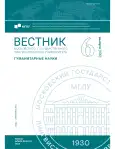Identification Significance of Accentual Vowels’ Formant Characteristics for Russian Speech of L2 Karachay-Balkar Speakers
- Authors: Gurtueva I.A.1
-
Affiliations:
- KBSC RAS
- Issue: No 6(900) (2025)
- Pages: 41-49
- Section: Linguistics
- URL: https://journal-vniispk.ru/2542-2197/article/view/301080
- ID: 301080
Cite item
Full Text
Abstract
The present paper analyzes acoustic measurements and normalized representations of vowels realized in the interfered Russian speech of native Karachay-Balkar speakers. The primary probabilistic-statistical analysis was performed on the materials of formant measurements of a large set of vowel tokens recorded in the form of phonation reading of a pre-prepared list of words. Then, the data transformed by Lobanov’s method to reduce the variability associated with the individual characteristics of the informants were considered. The results showed a systematic deviation of the acoustic patterns of vowel allophones in the F1–F2 space, as well as their representations in the space of pronunciation features. The present study is aimed at detecting features that have sufficient identification significance for subsequent use in automatic systems of non-native speech recognition, accent identification, linguistic expertise, or voice biometrics.
About the authors
Irina Aslanbekovna Gurtueva
KBSC RAS
Author for correspondence.
Email: gurtueva-i@yandex.ru
Senior Lecturer at the Scientific and Educational Center
Russian FederationReferences
- Lado, R. (1957). Linguistics across Cultures. Ann Arbor: University of Michigan Press.
- Wardhaugh, R. (1970). The Contrastive Analysis Hypothesis. In TESOL Quarterly, 4(2), 120–130.
- Oller, J. W., Ziahosseiny, S. M. (1970). The Contrastive Analysis Hypothesis and Spelling Errors. Language Learning, 20(2), 183–189. doi: 10.1111/j.1467-1770.1970.tb00475.x.
- Major, R. C. (2008). Transfer in second language phonology: A review. In Edwards, J. G. H., Zampini, M. L. (Eds.), Phonology and Second Language Acquisition (ch. 3, pp. 63–94). Amsterdam ; Philadelphia: John Benjamins Publishing.
- Gurtueva, I. A. (2025). Formant Analysis of Accented Russian Speech of Karachay-Balkar Speakers (based on vowel phonemes). Proceedings of II Scientific and Practical Conference (pp. 152–158). Moscow: MSLU. (In Russ.)
- Gurtueva, I. A. (2024a). Corpus Study of the Accented Russian Speech. Proceedings of I Scientific and Practical Conference (pp. 56–62). Moscow: MSLU. (In Russ.)
- Sorokin, V. N., Tsyplikhin, A. I. (2004). Vowel Segmentation and Recognition. Information Processes, 4(2), 202–220. (In Russ.)
- Kozlachkov, S. B., Dvoryankin, S. V., Bonch-Bruevich, A. M. (2016). Limitations for Formant Theory of Speech Intelligibility in Speech Information Security Applications. Voprosy Kiberbezopasnosti, 5(18), 28–35. (In Russ.)
- Gurtueva, I. A. (2024b). An Experimental Study of the Phonetic Realization of Russian Speech by Native Speakers of Karachay-Balkar. Philology. Theory & Practice, 17(9), 3098–3105. doi: 10.30853/phil20240439. (In Russ.)
- Gurtueva, I. A., Kamensky, M. V. (2024). Interfered Russian Speech of Native Speakers of the Kabardian-Circassian Language: An Experimental Study. Science Journal of Volgograd State University. Linguistics, 23(4), 119–141. doi: 10.15688/jvolsu2.2024.4.10. (In Russ.)
- Lobanov, B. M. (1971). Classification of Russian vowels spoken by different speakers. In JASA, 49(2), 606–608.
- Adank, P., Smits, R., van Hout, R. (2004). A comparison of vowel normalization methods for language variation research. JASA, 116(5), 3099–3107.
- Cherepanova, O. D. (2019). Lingvisticheskoe obespechenie foneticheskikh trenazherov pri obuchenii nemetskomu yazyku (na materiale russkogo I nemetskogo yazykov) = Linguistic support of phonetic trainers in teaching German (based on vocalism of Russian and German languages) specialty: PhD thesis in Philology. Moscow. (In Russ.)
Supplementary files










